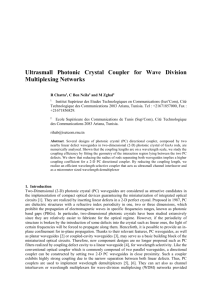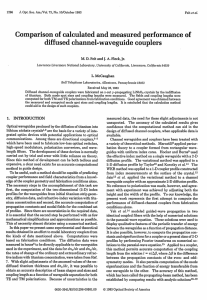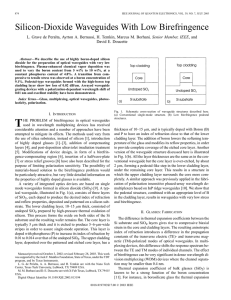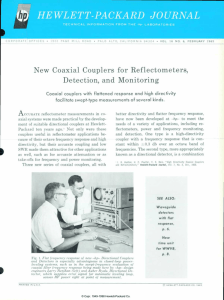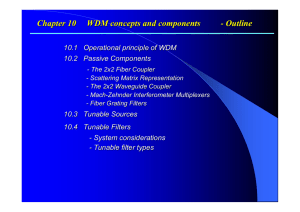Tunable Optical Directional Coupler Design & Simulation
advertisement
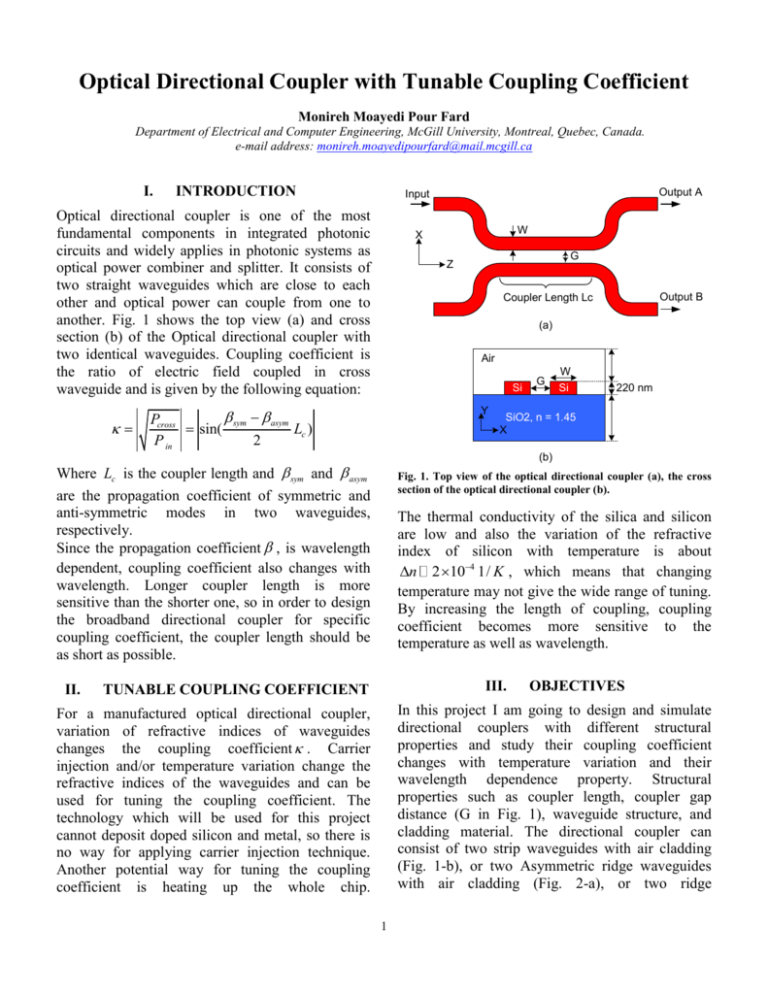
Optical Directional Coupler with Tunable Coupling Coefficient Monireh Moayedi Pour Fard Department of Electrical and Computer Engineering, McGill University, Montreal, Quebec, Canada. e-mail address: monireh.moayedipourfard@mail.mcgill.ca I. INTRODUCTION Optical directional coupler is one of the most fundamental components in integrated photonic circuits and widely applies in photonic systems as optical power combiner and splitter. It consists of two straight waveguides which are close to each other and optical power can couple from one to another. Fig. 1 shows the top view (a) and cross section (b) of the Optical directional coupler with two identical waveguides. Coupling coefficient is the ratio of electric field coupled in cross waveguide and is given by the following equation: W X G Z Output B Coupler Length Lc (a) Air Si asym Pcross sin( sym Lc ) P in 2 Y G W Si 220 nm SiO2, n = 1.45 X (b) Where Lc is the coupler length and sym and asym are the propagation coefficient of symmetric and anti-symmetric modes in two waveguides, respectively. Since the propagation coefficient , is wavelength dependent, coupling coefficient also changes with wavelength. Longer coupler length is more sensitive than the shorter one, so in order to design the broadband directional coupler for specific coupling coefficient, the coupler length should be as short as possible. II. Output A Input Fig. 1. Top view of the optical directional coupler (a), the cross section of the optical directional coupler (b). The thermal conductivity of the silica and silicon are low and also the variation of the refractive index of silicon with temperature is about n 2 104 1/ K , which means that changing temperature may not give the wide range of tuning. By increasing the length of coupling, coupling coefficient becomes more sensitive to the temperature as well as wavelength. III. TUNABLE COUPLING COEFFICIENT OBJECTIVES In this project I am going to design and simulate directional couplers with different structural properties and study their coupling coefficient changes with temperature variation and their wavelength dependence property. Structural properties such as coupler length, coupler gap distance (G in Fig. 1), waveguide structure, and cladding material. The directional coupler can consist of two strip waveguides with air cladding (Fig. 1-b), or two Asymmetric ridge waveguides with air cladding (Fig. 2-a), or two ridge For a manufactured optical directional coupler, variation of refractive indices of waveguides changes the coupling coefficient . Carrier injection and/or temperature variation change the refractive indices of the waveguides and can be used for tuning the coupling coefficient. The technology which will be used for this project cannot deposit doped silicon and metal, so there is no way for applying carrier injection technique. Another potential way for tuning the coupling coefficient is heating up the whole chip. 1 Air G si Y Table 1. Primary estimation of the waveguide size for different waveguide structure with air and SiO2 cladding and the gap (G) distance of 100 nm in wavelength of 1550 nm. Air W Si G 220 nm si Y SiO2, n = 1.45 X (a) W Si 220 nm Type of waveguide Strip Ridge AsymmetricRidge SiO2, n = 1.45 X (b) Air Polymer Si Y G W Si Si 220 nm SiO2 cladding COCL*(µm) 14.6 8.3 2.9 Width (W) (µm) 0.5 0. 5 0.45 * COCL, “Cross-over Coupler length” is the length which the coupling coefficient is equal to 1 SiO2, n = 1.45 X (c) Fig. 2. Cross section of different waveguide structures. Asymmetric ridge waveguide with air cladding (a), symmetric ridge waveguide with air cladding (b), Strip waveguide with polymer cladding (c). waveguides with air cladding (Fig. 2-b), or using another material such as polymer or SiO2 as cladding (Fig. 2-c). Applying polymer with more sensitivity to the temperature can increase the range of tuning. IV. Air cladding COCL*(µm) 32 8.15 2.85 DESIGN METHODALOGY At first step by using Lumerical mode solver the supermode effective indices are found and the required length for coupling coefficient 1 is calculated. In next step the temperature effect will be studied by sweeping the effective indices changes based on temperature variation. The wavelength-dependence property of directional coupler will be studied by sweeping the effective indices changes based on wavelength variation. The whole process will repeat for directional couplers with different structural properties. Table 1 has been summarized the primary estimation of the waveguide size for wavelength of 1550 nm. As it is expected and has been shown in the table, the strip waveguide is much more sensitive to the refractive index of the cladding. 2

